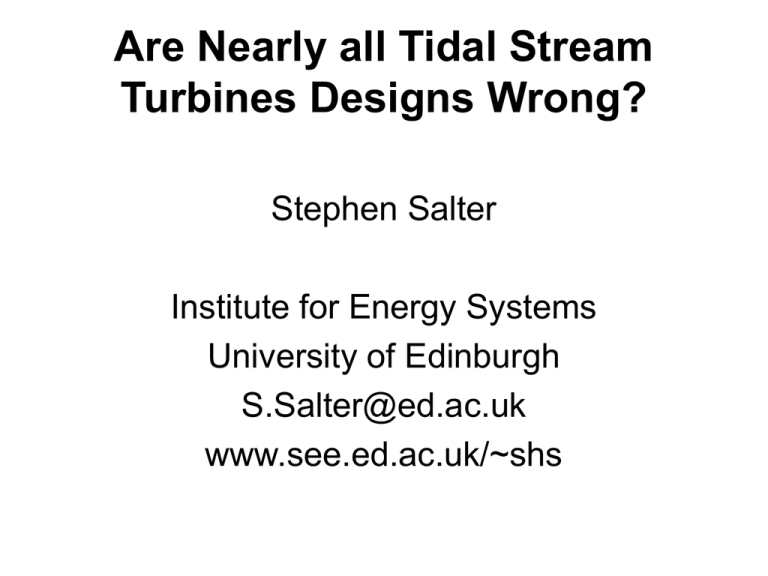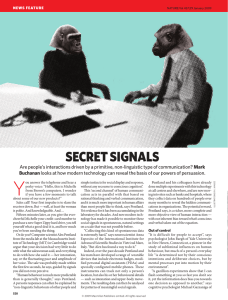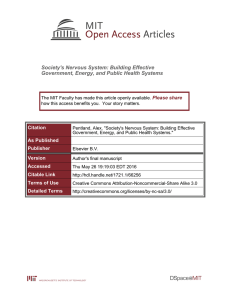Are Nearly all Tidal Stream Turbines Designs Wrong?
advertisement

Are Nearly all Tidal Stream Turbines Designs Wrong? Stephen Salter Institute for Energy Systems University of Edinburgh S.Salter@ed.ac.uk www.see.ed.ac.uk/~shs Cells are 1 minute of arc lat. 1.5 minutes long = 2.617 km2. Power = 6.165 TW x Cf Peak spring Pentland sea-bed friction = 6.165 TeraWatt x Cf But what is Cf ? From Black and Veatch 2011. Using values for the Pentland Firth U = 3m/s, ρ = 1025 kg/m3, channel length = 23 km, channel width = 10 km in combination with a more appropriate bed friction coefficient CD = 0.0015 energy dissipated due to bed friction averaged over a tidal cycle calculated is 4.05 GW. Laminaria Hyperborea (kelp) are found along the edges of the Pentland Firth at depths up to 30 m. Length can reach 3.5 metres. Cf = ? 68 mm bob Pentland bed stills. P Hayes. Fisheries Research Aberdeen 2006-8 Friction coefficients for Fshear = 0.5 ρ U2 Cf Source Campbell, Simpson and Allen Estuarine Coastal and Shelf Science vol 46 1998. George K. Hydrographic Journal October 2005 Abbot and von Doenhoff. Dover 1959. CF for ½ ρU2 Menai strait (0.0086 ± 0.0002) x 2 = 0.0172 Positions along Menai strait 0.006, 0.008, 0.013, 0.015, 0.018, 0.02 One side of a NACA 0006 fighter wing at 0 deg incidence. Rey No 6E6. Polished 0.0025 Standard roughness 0.0045 Bricker, Inagaki and Monismith. ASCE Journal of Hydraulic Engineering June 2005. Combinations of waves and currents with results depending on ratio of current at one metre above bed to maximum orbital wave velocity. San Franciso Bay. Silt and fine sand. 0.004 (low waves) to 0.08 Rippeth, Williams and Simpson. Journal of Physical Oceanography vol 32, 2002. Menai Strait with ADCP and mean depth current 0.0052 ± 0.0004 Vitale ASCE Journal of Waterway,Port, Coastal and ocean Division August 1979. Bagnold. Proc. Roy. Soc. December 1946. Average wave friction from many sites 0.094, 0.1, 0.106, 0.116,0.166, 0.28 Waves with sand ripples 0.05, 0.144, 0.16, 0.18, 6.165 TeraWatt x 0.04 = 247 GW X 0.38 = 93.7 GW at peak spring O’Doherty DM. Mason-Jones Morris, O’DohertyT, Bryne, Pricket, Grosvenor. Interaction of marine turbines in close proximity. EWTEC 2011 3 2.75 0.55 3.35 3 2.75 0.58 3.3 NASA EWTEC Patras 1998 Edinburgh vertical-axis, variable pitch with rim power take off. Downstream force on a 140 diameter rotor as a fraction of ideal 1.2 1.2 1 0.8 fds i4 FDSi4 0.6 0.4 0.2 0 0 70 60 50 40 30 20 10 DR 2 0 Xi 10 20 30 40 50 60 DR 2 70 R.A. McAdam , G.T. Houlsby , M.L.G. Oldfield Structural and Hydrodynamic Model Testing of the Transverse Horizontal Axis Water Turbine EWTEC 2011 Speed up x 30 Range up x 6000 Payload up x 20,000 Cost down ÷ 100 Something for the simpletons Variable pitch advantages Easy tow to installation site with 2.5% drag of circular members Agile self propulsion Instant disconnection of delivered power Relief of bending stress in rings Avoidance of cavitation Double performance at lower tip speed ratios for 1.5% extra cost Online conversion from open flow field to close packed Survivor repulsion Sibling assistance Reactive loading to tune Pentland Firth to M2 Potential for delayed generation Degrees lag Phase by zero crossings 63.4 Phase by real and imaginary M2 spectral FFT peaks of slope and velocity 58.1 Phase by voltage induced by the earth’s magnetic field 68 Problems for horizontal-axis axial-flow rotors Lower efficiency near the hub. Low packing-fraction means poor use of resource. Longer power cables. Higher bending moments at the blade roots. Coincidence of shear and bending stress. Vortex shedding at blade tips. Tower leverage. Hydrodynamic wake pollution. Sensitivity to flow direction change. Volume constraint for pitch mechanism. Betz limit. Bearing leverage. Bending moments limit power rating. Hydrostatic pressure variation. Submerged power-conversion mechanism. Lack of space for power conversion. Submerged main bearings. Less power smoothing. More expense for tapered and twisted hydrofoils. No bridge option. Need for high rubbing seal velocity . . . . . . . . . . . . . S.Salter@ed.ac.uk www.see.ed.ac.uk/~shs







